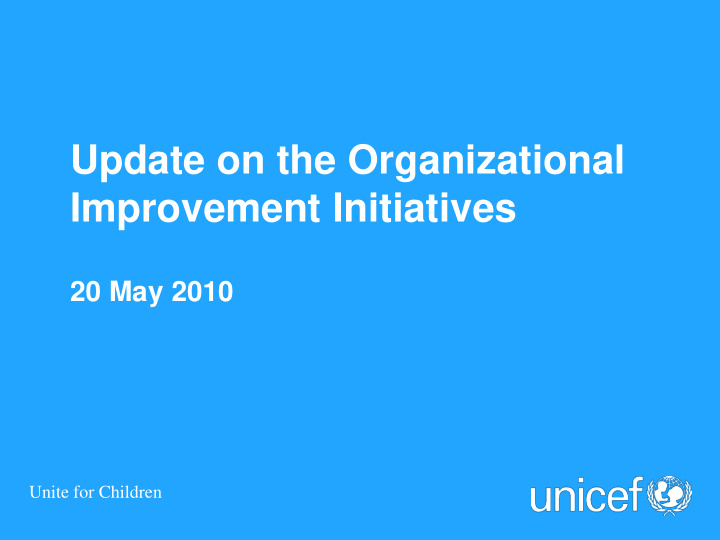



Update on the Organizational Improvement Initiatives 20 May 2010 Unite for Children
Organizational Review Report, 2007: Five Strategic Shifts Recommended • Sharpen Programme Focus, Formulation & Strategy • Realign Structures & Systems to Deliver Quality Results • Position UNICEF as a Global Knowledge Leader for Children • Enhance Partnerships for Resources & Results • Manage for Performance 2
Ten Organizational Improvement Initiatives Dynamic Accountability Programmes Organizational System Performance Knowledge & Business Process Improvement ERM Content Management One ERP Talent / Leadership Global Management / Partnerships Internal Development Communication 3
Four Result Areas of the Organizational Improvement Process Accountability & Risk Management Effective Resource Planning & Implementation IPSAS Programme Operations Excellence Performance 4
1. Improved Accountability and Effective Risk Management Better understanding of roles, responsibilities and functions and more risk informed management policies and practices Progress to date: • Accountability System Paper approved June 2009 • Enterprise Risk Management Policy issued May 2009 Ongoing Work: • Internal Accountability Framework being updated • Risk management training, tools and governance mechanisms being rolled out • Regulatory Framework being updated 5
2. Programme Excellence UNICEF programmes are more dynamic, strategic, responsive and innovative Progress to date: • Simplified programme results structure and multi-year/rolling workplan developed and piloted at country level • Programme Cooperation Agreement and Small Scale Funding Agreement modalities improved • Strategic Framework for Partnerships and Collaborative Relationships approved June 2009 • Communities of Practice institutionalized among knowledge management tools 6
2. Programme Excellence (cont). Ongoing Work: • Simplified programme results structure and multi-year/rolling workplans implemented in all offices – Programme component results (PCR) and intermediate results (IR) more focused on results for children – Complementary to interagency programming efforts and UNDAF – Ensure greater harmonization with national planning, budgeting and reporting cycles • Plan of action for Strategic Framework for Partnerships and Collaborative Relationships being implemented • Knowledge Management Framework being developed 7
3. Operations Performance More efficient business models and processes optimize the use of organizational resources Progress to date: • New and Emerging Talent (NETI); Leadership and Development (LDI) Initiatives; Management Development and Assessment Centres (MADC) launched • E-PAS: on-line 180° performance appraisal system • UNICEF Employment (e-Recruitment) on-line • ICON – Internal Communications Network • Business process simplification in procurement, travel management, harmonized cash transfers, contract review and approval, etc. 8
3. Operations Performance (cont.) Ongoing Work: • Supply Customer Relationship Management system – New web-based supply catalogue – Improved customer enquiry management – On-line cost estimates and order tracking for internal and external customers • New procedures developed for general service recruitment and performance assessment 9
4. Effective Resource Planning and Implementation and IPSAS Web-based enterprise resource planning system provides single organizational platform for implementation of improvements and adoption of IPSAS Progress to date: • Blueprint for realization of VISION/One ERP finalized, integrating business process improvements and IPSAS compliance requirements • Architecture for Performance Management Information System established • Roadmap for IPSAS compliance 10
4. Effective Resource Planning and Implementation and IPSAS (cont.) Ongoing Work: • Programme Manager Dashboard being introduced: – Operations Performance – Programme Performance Reporting • VISION / One ERP effective 1 January 2012 in all offices • IPSAS Compliance as of 1 January 2012 • Full Performance Management Information System organization-wide 11
Ensuring Success of the Organizational Improvement Process • Strengthened governance and coordination through: – Convergence of four result areas under single project board – Network of Divisional Coordinators – Draft improvement results framework • Increased internal and interagency consultation provides valuable feedback: – Workshops and WebEx sessions with Field Reference Group members and country office pilots – Participation in UN Coherence and Delivering as One fora – Headquarters-level interagency networks 12
Ensuring Success of the Organizational Improvement Process (cont.) • Engagement of senior management at all levels to lead change – Regional Management Team meetings – Deputy Representative and Operations Managers meetings – Global and Regional Technical Network Meetings • Effective communication to all staff at all levels – Targeted approach for staff whose roles and functions are most affected – Capitalize on existing internal communication tools – Promote cascading and peer-to-peer communications 13
Ensuring Success of the Organizational Improvement Process (cont.) • Coordinated approach to learning and training: – In synch with improvement communications strategy – Minimum disruption to staff and offices – Linked to country programme cycles – Phased, hands-on, learner centred and cascading approaches – Integrated into existing trainings and mechanisms • Implement 360° Intranet site: – Timely information sharing – Information resource on all improvement issues 14
2010 2011 January 2012 January 2011 IPSAS Compliance June 2010 Simplified Programme Supply Customer VISION / One ERP Results Structure & Multi- Relations Management year/rolling Workplans System Full Performance Management Information January 2011 December 2010 System Programme Manager Risk Management tools Dashboard component of & governance Performance Management mechanisms Information System Accountability Framework Regulatory Framework Implementation of the Plan of Action for Strategic Framework for Partnerships & Collaborative Relationships 15 Improvements Training and Roll Out
Recommend
More recommend